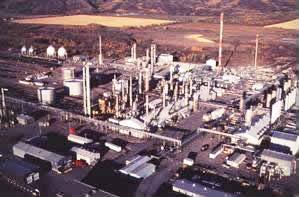Natural gas

Natural gas is a naturally occurring hydrocarbon gas mixture consisting primarily of methane, but commonly including varying amounts of other higher alkanes, and sometimes a small percentage of carbon dioxide, nitrogen, hydrogen sulfide, or helium. It is formed when layers of decomposing plant and animal matter are exposed to intense heat and pressure supplied by existing under the surface of the Earth over millions of years. The energy that the plants originally obtained from the sun is stored in the form of chemical bonds in the gas.

Natural gas is a fossil fuel used as a source of energy for heating, cooking, and electricity generation. It is also used as fuel for vehicles and as a chemical feedstock in the manufacture of plastics and other commercially important organic chemicals. It is a non-renewable resource.
Natural gas is found in deep underground rock formations or associated with other hydrocarbon reservoirs in coal beds and as methane clathrates. Petroleum is another resource and fossil fuel found in close proximity to, and with natural gas. Most natural gas was created over time by two mechanisms: biogenic and thermogenic. Biogenic gas is created by methanogenic organisms in marshes, bogs, landfills, and shallow sediments. Deeper in the earth, at greater temperature and pressure, thermogenic gas is created from buried organic material.

When gas is associated with petroleum production it may be considered a byproduct and be burnt as flare gas. The World Bank estimates that over 150 billion cubic meters of natural gas are flared or vented annually. Before natural gas can be used as a fuel, it must beprocessed to remove impurities, including water, to meet the specifications of marketable natural gas. The by-products of this processing include: ethane, propane, butanes, pentanes, and higher molecular weight hydrocarbons, hydrogen sulfide (which may be converted into pure sulfur), carbon dioxide, water vapor, and sometimes helium and nitrogen.
Natural gas is often informally referred to simply as "gas", especially when compared to other energy sources such as oil or coal. However, it is not to be confused with gasoline, especially in North America, where the term gasoline is often shortened in colloquial usage to gas.
Natural gas was used by the Chinese in about 500 BC (possibly even 1000 BC[7]). They discovered a way to transport gas seeping from the ground in crude pipelines of bamboo to where it was used to boil salt water to extract the salt,[8] in the Ziliujing District of Sichuan. The world's first industrial extraction of natural gas started at Fredonia, New York, USA in 1825. By 2009, 66 trillion cubic meters (or 8%) had been used out of the total 850 trillion cubic meters of estimated remaining recoverable reserves of natural gas. Based on an estimated 2015 world consumption rate of about 3.4 trillion cubic meters of gas per year, the total estimated remaining economically recoverable reserves of natural gas would last 250 years at current consumption rates. An annual increase in usage of 2–3% could result in currently recoverable reserves lasting significantly less, perhaps as few as 80 to 100 years.
No comments:
Post a Comment